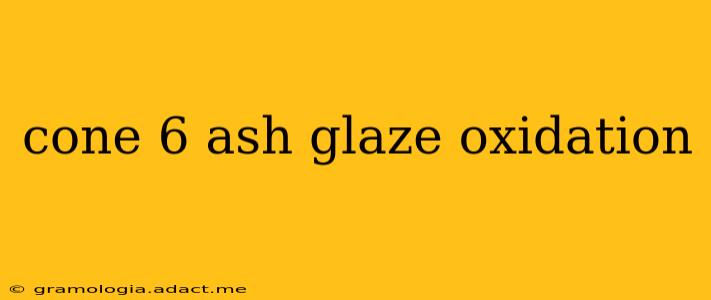Ash glazes, renowned for their earthy tones and unique character, are a favorite among ceramic artists. Achieving the perfect cone 6 ash glaze in oxidation firing, however, requires a nuanced understanding of several key factors. This guide delves into the intricacies of creating stunning cone 6 ash glazes under oxidizing conditions, addressing common questions and providing practical tips for success.
What is a Cone 6 Ash Glaze?
A cone 6 ash glaze is a type of ceramic glaze made primarily from the ashes of wood, plants, or other organic materials. The ash provides a rich source of minerals such as silica, alumina, and alkalis, which contribute to the glaze's unique properties and aesthetic appeal. Cone 6 refers to the temperature at which the glaze matures during firing (approximately 2232°F or 1222°C). Oxidation firing means the kiln atmosphere is rich in oxygen, which promotes a brighter, more vibrant color palette compared to reduction firing.
What Makes Cone 6 Ash Glazes Unique?
Cone 6 ash glazes stand out due to their:
- Varied Color Palette: The specific composition of the ash, along with the firing conditions, yields a wide range of colors from subtle creams and tans to deep browns and grays. The presence of trace elements within the ash can also create unexpected and beautiful variations.
- Natural Aesthetics: These glazes often showcase a unique texture, sometimes exhibiting a crystalline or matte finish, adding to their organic appeal. They can also display subtle variations in color and texture across a single piece, reflecting the natural variability of the ash itself.
- Sustainable Approach: Using ash as a glaze material promotes a sustainable approach to ceramics, utilizing readily available waste materials and reducing the environmental impact of ceramic production.
How to Make a Cone 6 Ash Glaze in Oxidation
The process of creating a cone 6 ash glaze involves several steps:
-
Ash Collection and Preparation: Gather the ash from a reliable source, ensuring it's free of contaminants. Sieve the ash to remove any large particles, resulting in a finer, more consistent material for glazing.
-
Testing and Refinement: Before applying the glaze to your final pieces, perform test firings to determine the optimal ash-to-other-materials ratio. Experiment with different additions like silica, feldspar, and kaolin to adjust the glaze's fluidity, melting point, and overall aesthetic.
-
Glaze Application: Once you have a refined recipe, apply the glaze to your bisque-fired pottery using your preferred method, whether dipping, pouring, or spraying. Ensure even coverage for consistent results.
-
Firing in Oxidation: Fire your glazed pieces in an oxidation kiln to cone 6. Monitor the kiln carefully during firing to maintain a consistent oxidizing atmosphere.
-
Post-Firing Considerations: Allow your finished pieces to cool slowly in the kiln after firing. The final result is a unique, aesthetically pleasing glaze reflecting the inherent characteristics of the ash and the firing process.
What are the Common Problems with Cone 6 Ash Glazes?
Cracking: This is often caused by insufficient silica or rapid cooling. Adjust your recipe to include more silica or implement a slower cooling schedule for the kiln.
Pinholing: Small holes in the glaze surface, often caused by trapped gases during firing. This can be minimized by ensuring the glaze is thoroughly mixed and free of lumps.
Crawling: The glaze pulls back and leaves bare patches, typically a consequence of incompatibility between the glaze and the clay body. Choose a clay body compatible with your glaze recipe.
How do I Achieve a Specific Color with Cone 6 Ash Glaze?
The color of your ash glaze is highly dependent on the source of ash and the additions you make to the recipe. Experimentation is key. Testing different ash sources (wood ash, plant ash, etc.) and making small adjustments to the recipe (adding iron oxide for deeper colors or zinc oxide for a more matte finish) will allow you to achieve your desired color.
What are the Differences Between Reduction and Oxidation Firing for Ash Glazes?
Reduction firing, characterized by a low-oxygen atmosphere, typically produces warmer, more muted colors in ash glazes. Oxidation firing, with its oxygen-rich atmosphere, results in brighter, clearer colors. The choice between reduction and oxidation depends on your desired aesthetic outcome.
Can I Use Different Types of Ash in My Cone 6 Ash Glaze?
Yes, you can experiment with various ash sources (wood, plant, rice hull, etc.). Each type of ash will contribute unique minerals that affect the glaze's color and properties. Remember to thoroughly test each new ash source before committing it to your final pieces.
This guide provides a thorough overview of cone 6 ash glazes in oxidation. By understanding the key factors involved and employing careful experimentation, you can unlock the stunning potential of these unique and rewarding glazes. Remember, practice and patience are essential to mastering the art of ash glazes.
